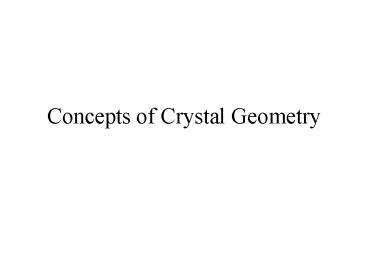Concepts of Crystal Geometry - PowerPoint PPT Presentation
1 / 17
Title:
Concepts of Crystal Geometry
Description:
Concepts of Crystal Geometry. X-ray diffraction analysis shows that the atoms ... A crystallographic plane is specified in terms of the length of its intercepts ... – PowerPoint PPT presentation
Number of Views:32
Avg rating:3.0/5.0
Title: Concepts of Crystal Geometry
1
Concepts of Crystal Geometry
2
- X-ray diffraction analysis shows that the atoms
in a metal - crystal are arranged in a regular, repeated
three-dimensional - pattern.
- The most elementary crystal structure is the
simple cubic lattice - (Fig. 9-1).
Figure 9-1 Simple cubic structure.
3
- We now introduce atoms and molecules, or
repeatable - structural units.
- The unit cell is the smallest repetitive unit
that there are 14 - space lattices.
- These lattices are based on the seven crystal
structures. - The points shown in Figure 9-1 correspond to
atoms or groups - of atoms.
- The 14 Bravis lattices can represent the unit
cells for all - crystals.
4
Figure 9-2 (a) The 14 Bravais space lattices (P
primitive or simple I body-centered cubic F
face-center cubic C base-centered cubic
5
Figure 9-2(b)
6
Figure 9-2(c)
7
Figure 9-2(d)
8
Figure 9-2(e)
9
Figure 9-2(f)
10
Figure 9-3 a) Body-centered cubic structure b)
face-centered cubic structure.
11
Figure 9-4 Hexagonal close-packed structure
Figure 9-5 Stacking of close-packed spheres.
12
- Three mutually perpendicular axes are arbitrarily
placed through one of the corners of the cell. - Crystallographic planes and directions will be
specified with - respect to these axes in terms of Miller
indices. - A crystallographic plane is specified in terms
of the length of its intercepts on the three
axes, measured from the origin of the coordinate
axes. - To simplify the crystallographic formulas, the
reciprocals of these intercepts are used. - They are reduced to a lowest common denominator
to give the Miller indices (hkl) of the plane.
13
- For example, the plane ABCD in Fig. 9-1 is
parallel to the - x and z axes and intersects the y axis at one
interatomic - distance ao. Therefore, the indices of the
plane are - , or (hkl)(010).
Figure 9-1 Simple cubic structure.
14
- There are six crystallographically equivalents
planes of - the type (100).
- Any one of which can have the indices (100),
(010), - (001), depending
upon the choice of - axes.
- The notation 100 is used when they are to be
considered - as a group,or family of planes.
15
- Figure 9.6(a) shows another plane and its
intercepts.
Figure 9-6(a) Indexing of planes by Miller
indices rules in the cubic unit cell
16
- As usual, we take the inverse of the intercepts
and multiply them by their common denominator so
that we end up with integers. In Figure 9.6(a),
we have
17
- Figure 9.6(b) shows an indeterminate situation.
Thus, we have to translate the plane to the next
cell, or else translate the origin.
Figure 9-6(b) Another example of indexing of
planes by Miller rules in the cubic unit cell.































